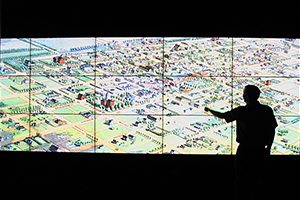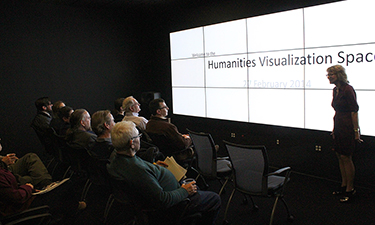What if reading no longer meant looking at words on a page? What if, instead of staring at a physical text, you could interact with it through touch, sight, and sound?
This is now possible in the College of Liberal Arts thanks to touchscreen upgrades in the Humanities Visualization Space (HVS), a high-tech facility aimed at improving humanities research through the use of technology. The upgrades were made possible by a gift from J.C. “Chris” and Sally Gavras, both Aggie Class of 1986.
 The Humanities Visualization Space is a project of the Initiative for Digital Humanities, Media, and Culture.
The Humanities Visualization Space is a project of the Initiative for Digital Humanities, Media, and Culture.
The Humanities Visualization Space is comprised of 15 high-definition LCD monitors, which together create a screen that is more than 5 feet tall and 16 feet wide with a resolution of 3240×9600, enabling users to zoom in on works of art and literature and see fine details that might not otherwise be visible. The 31-megapixel display can be used for a variety of humanities projects that use the space in creative ways, from analyzing and comparing digitized works of art and literature to interactive performance art pieces made possible by modern technology.
“One of the goals of the center is to really help faculty who are traditional scholars come to the digital humanities and not see it as the enemy,” said Dr. Laura Mandell, Professor of English and Director of the Initiative for Digital Humanities, Media, and Culture (IDHMC), which aims to help student and faculty researchers access and understand a variety of digitized cultural heritage sources. The IDHMC encompasses several projects on campus, including the visualization space.
In addition to a unique opportunity to view digitized materials in large scale, the HVS provides an interface to access, search, and study digital cultural sources from institutions around the world.
“The HVS is a place where researchers and students can collaborate to explore digital cultural heritage materials, and to save materials that interest them, or to create their own projects containing such materials,” Mandell said.
In 2015, the HVS hosted an event to remotely watch the #RiseUpOctober march in New York City organized by the Black Lives Matter movement. Participants monitored multiple social media platforms including Facebook, Twitter, and Instagram simultaneously on the big screen to explore the role of social media in contemporary social movements.
“The Rise Up October event [in the HVS] was really innovative and interesting because it gave people an immersive experience of an event far away that was important to them,” Mandell said. “It’s a great way to get people really involved in an event … They can’t be there, but they can come here and really get an immersive experience.”
 Dr. Mandell gives a presentation in the Humanities Visualization Space.
Dr. Mandell gives a presentation in the Humanities Visualization Space.
Digital humanities technology has a multitude of applications, Mandell noted, and can benefit faculty and scholars as well as students. Studying art and literature becomes an immersive experience through the use of technology such as the HVS and other digital tools.
“It really is transformative for my students,” she said. In contrast to sitting still and staring at a physical text, “moving around and putting things up on the screen changes the learning experience.”
Although working with technology can be frustrating at times, Mandell admitted, digital humanists develop research and problem-solving skills through the experience of working with humanities technology.
“Technology is not a toaster,” she said. “It’s not something that either is broken or not; it’s something that you have to play with to get it to do what you want it to do.”
The improvements to the HVS are only some of the exciting developments happening for the IDHMC, Mandell noted, emphasizing the program’s ongoing growth to support more staff, faculty, and students.
The gift making these improvements possible was part of the Lead by Example campaign at Texas A&M. Learn more about how to support the College of Liberal Arts.
By Sid Mitchell '16
This article was originally published by the College of Liberal Arts.
Texas A&M Foundation
The Texas A&M Foundation is a nonprofit organization that solicits and manages investments in academics and leadership programs to enhance Texas A&M’s capability to be among the best universities.
You can support the College of Liberal Arts with a gift of an endowment to the Texas A&M Foundation. For additional information about how to benefit the college, contact Larry Walker ’97 with the Foundation at (800) 392-3310, (979) 458-1304 or lwalker@txamfoundation.com.